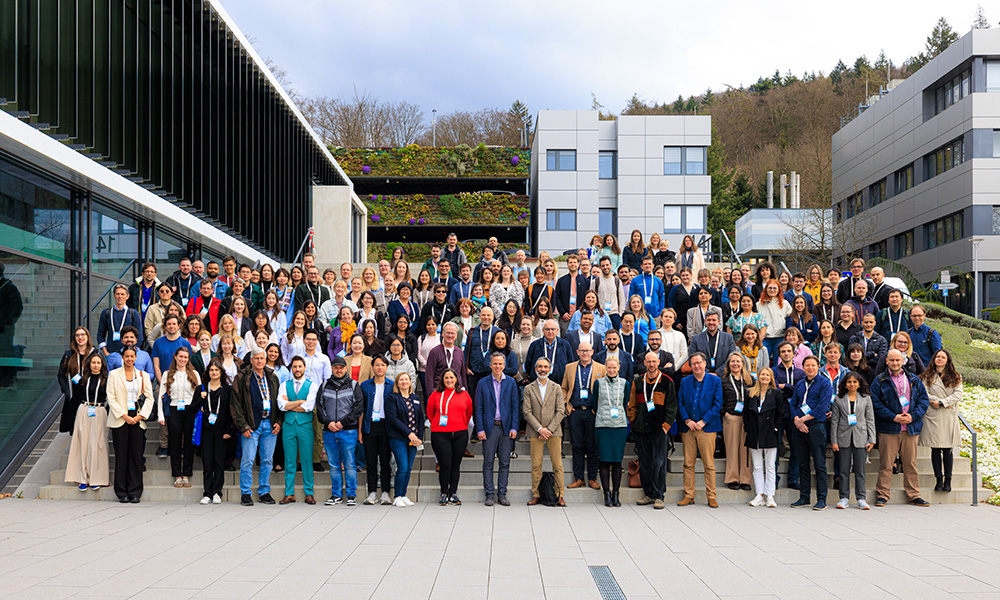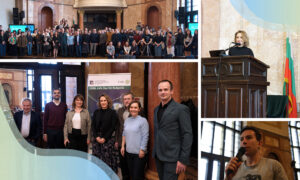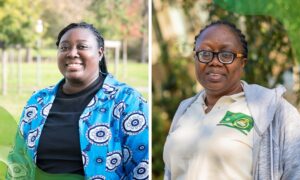
EMBL Partnership Conference explores AI in One Health
Scientific representatives from across Europe and beyond discuss potential of AI in life sciences

Recent advancements in AI are revolutionising life sciences, offering new possibilities across research disciplines. The fifth EMBL Partnership Conference brought together participants from EMBL and its partner institutions to explore how AI can drive innovation in One Health – a concept that bridges biomedical research across fields.
Over three days, experts delved into AI’s transformative role in three key areas: molecular medicine and precision health, genetics and genomics, and technology and imaging. Organised by scientists from EMBL, the Laboratory for Molecular Infection Medicine Sweden (MIMS), Michael Sars Centre, Vilnius University Life Sciences Center, and EMBL Australia, the event fostered discussions on cutting-edge research and future directions.
Jan Korbel, Interim Head of EMBL Heidelberg and MMPU group leader, opened the conference, followed by a keynote by Giorgio Metta from the Italian Institute of Technology on AI for RNA Interactions, disease prediction, and therapeutic design. Beyond presentations, the event provided a platform for networking and new collaborations, including a dedicated Young Investigators Meeting, where predocs and postdocs exchanged ideas and built connections for future research.
Participants from various institutes offered insights into AI’s role in transforming human health, research, and collaboration:
A platform for sharing knowledge
EMBL holds a partnership conference every 3 years to encourage interactions with and across its partnership network.
“The conference is organised by EMBL’s International Relations in close collaboration with scientific experts from EMBL and the partner institutes.” said Plamena Markova, EMBL Chief of International Relations. “The conference focus changes each time; however, the key objective is to pool the complementary expertise of all partners around a topic of common interest and explore it in a way that ultimately leads to new ideas and joint scientific projects.”
“This partnership meeting is fantastic for taking stock of all ongoing within the partnerships,” said Oliver Billker, Director of the Laboratory for Molecular Infection Medicine Sweden (MIMS) and a conference organiser. “I see AI as a unifying factor at the moment that brings our thinking together. Although our different [Nordic EMBL] partnership institutes have completely different foci within molecular medicine, we are all to different degrees now asking ourselves how we can apply AI.”
This view is shared by other participants, among them, Karri Lämsä, core group leader at the Hungarian Centre of Excellence for Molecular Medicine (HCEMM). “The talks are fantastic. They always represent the crest of the wave,” Lämsä said. “The individual lectures are thoughtfully picked up to represent various different fields, and they all represent the latest developments.”
“I’m realising that AI is the future, so I think it’s really important to get more knowledge about it. I was happy that I was able to understand most of the talks and get some ideas for my project,” said Amanda Muñoz Juan, a NORPOD postdoc at the Danish Research Institute of Translational Neuroscience (DANDRITE) and MIMS. She was also glad to finally connect with her Swedish research group. “Here, I had the opportunity to meet them in person and talk about the project, present what I’ll do in these two and a half years, and get new ideas and feedback on which experiments will be best for me.”
I’m realising that AI is the future, so I think it’s really important to get more knowledge about it.
Also, Rūta Matulevičiūtė, predoc at the Vilnius University Life Sciences Centre (VU LSC), was drawn to the conference because of its focus on AI. “This is a big topic at the moment to consider. Since I’m just beginning my PhD studies, I’m still exploring a lot of ideas on what methods I could use, in what direction I could go.”
Matulevičiūtė was also an organiser of the conference’s Young Investigator Meeting. “It was really interesting to collaborate with people from different partnership institutes for around half a year before the conference. It was a lot of writing and communicating, talking with them. So, I developed a lot of soft skills during that time.”
New frontiers for AI in life sciences
The participants shared excitement about the new possibilities AI offers in analysing large, complex datasets.
“AI has shown that there are certain types of research data that it is pretty good at analysing,” said Samuli Ripatti, director of the Institute for Molecular Medicine Finland (FIMM). “Behind many of these ideas are the large language models currently. I think, in the short term, applying these existing tools or tweaking them a bit to apply to medically relevant questions is something that’s probably going to teach us a lot about how those tools work overall and their real potential.”
Anticipation is building also around using AI to integrate diverse data types, such as omics and imaging, to create 3D models of the cell and the processes within it.
I think in the future, AI will be able to predict, by looking at the transcriptomics and proteomics, what the cell looks like.
Linda Sandblad, MIMS team leader and director of Umeå Centre for Electron Microscopy, envisions great potential in combining omics and imaging data databases to model the cell in 3D. “I think in the future, AI will be able to predict, by looking at the transcriptomics and proteomics, what the cell looks like. Or, when you see what the cell looks like, use AI to identify its proteomics or metabolomics features. That could even be used in the future in a diagnostic way.”
AI challenges: common ground across disciplines
Despite its transformative potential, applying AI in life sciences poses several challenges.
Eduardo Eyras, EMBL Australia Group Leader at the Australian National University, develops methods using AI and machine learning and is keen to help others apply them in their work. “This is a great conference for that purpose. You meet people trying to solve completely different problems. And we run into the same problems, either technological or theory problems, to solve with different data sets.”
One such shared problem is AI hallucinations. Eyras stressed the need for affordable ways to validate AI predictions and feed the results back into the model to improve reliability. However, there are roadblocks. “In many areas, I don’t think we have enough data to make these models reliable enough. We probably need to define how much data and which data we need.” This may involve not just adding more data, but being strategic in collecting data – such as from missing clades, rare cell types, or underrepresented populations.
We run into the same problems, either technological or theory problems, to solve with different data sets.
Magdalena Szponar, predoc at the Nencki Institute in Poland, works with EEG data, which comes with its own set of hurdles. “In machine learning, a big problem is generalisation – a model that works for one kind of data does not always work for other kinds of data. EEG data are very dependent on the protocol of recording, like the clinical parameters, etc. So even [for data collected] at different institutions, we are not sure if it would work. But we are in progress of investigating that.”
Unlocking AI’s potential through collaboration across countries and disciplines
According to several participants, interdisciplinary collaboration is the way forward to overcome challenges and advance the applications of AI in life sciences in Europe.
For Anna Ferraioli, postdoc at the Michael Sars Centre in Norway, exchanging experiences on applying AI tools is key. “The number of [biologists] that can use AI effectively [and independently] is still very low. I think common application knowledge is fundamental because if you know what you can do, then you know how AI can be useful for your research. Talking to people here, I gained a bit of insight on how and where to start, what to do with tools, or what to do better. That’s been very useful.”
I think true collaboration means you actually get together, and use each other’s expertise to achieve something more – one plus one equals three.
Damla Övek Baydar, postdoc at the Norwegian Centre for Molecular Biosciences and Medicine (NCMBM), values the collaboration between experimental and computational scientists. “This way you can overcome many technical difficulties and make sure that AI models actually make sense in the real world. I think collaborating across disciplines and across countries is very important because we are trying to solve really important health-related issues, so they can have an impact on many people’s lives.”
David Brena, a scientific project manager at the Centre for Genomic Regulation in Spain, sees AI as a transversal tool benefiting both its developers and the wider life sciences community. “It’s a feedback loop in between the people that generate the data and those who consider how to make the data FAIR – findable, accessible, interpretable, and reproducible – and also how they can feed the ecosystem with bigger questions. I think this is also a way to connect planetary biology with human health and the One Health approach. EMBL makes this ecosystem out of many different inputs by connecting very different fields.”
Geert Kops, director of the Hubrecht Institute in the Netherlands, stressed the role of collaboration to advance AI in European life sciences. “I think true collaboration means you actually get together, and you use each other’s expertise to achieve something more – one plus one equals three. Europe is an amazing place for science. There are many places with unique expertise. I think EMBL has a central role there, because it’s a Europe-wide institute with a mission across all its Member States. So, if anybody can do it, EMBL can do it.”


